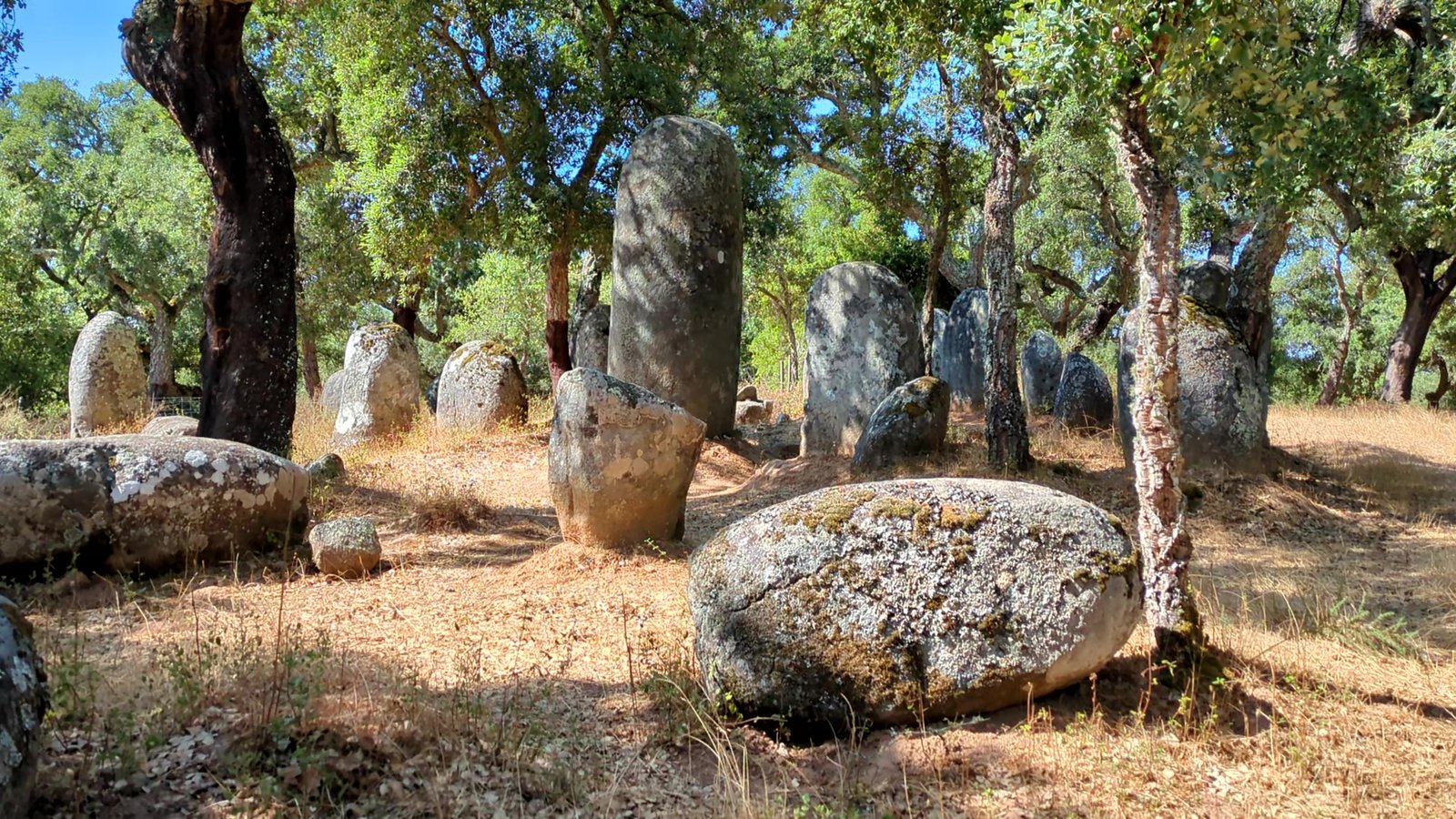Also known as: Cromeleque da Portela de Modos
Walk up the small hill, through the Alentejo cork oak forest. The wind blows through the trees, rustling the leaves. Up ahead, stand a group of still grey shapes. These stones have stood here for millennia, both upright and laying down. Once again they stand tall, dwarfed by the height of the surrounding trees, but proud in their timelessness.
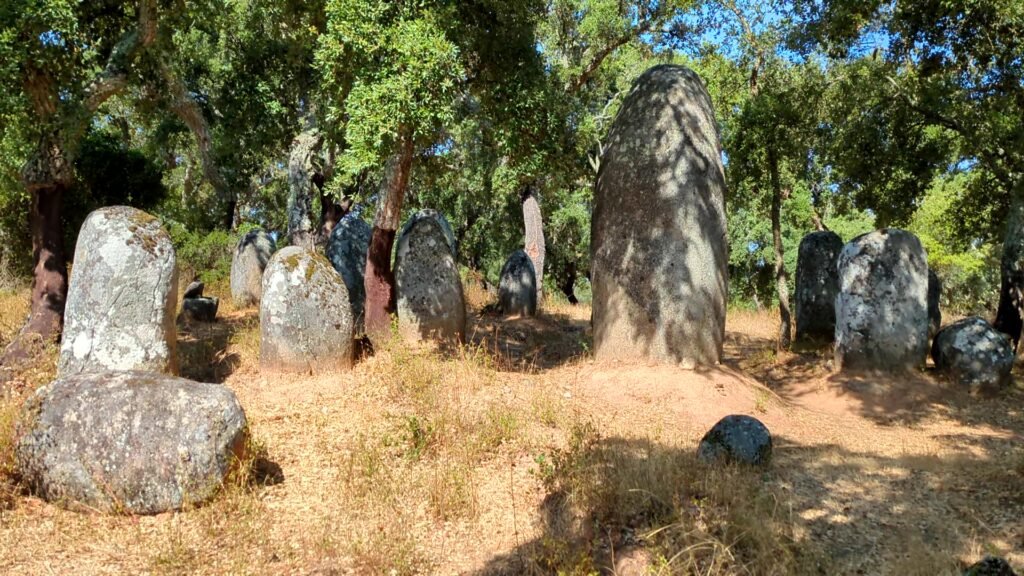

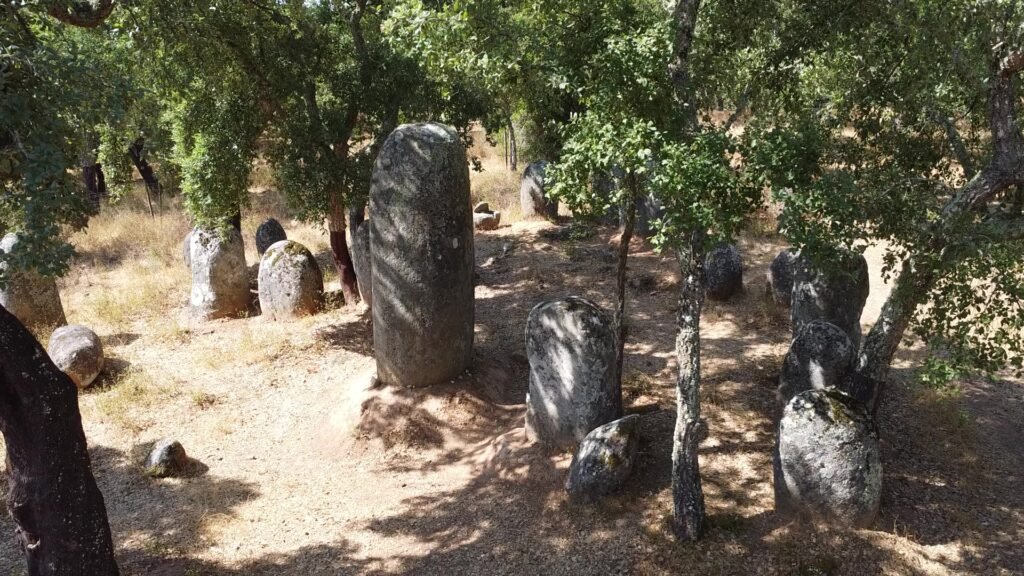
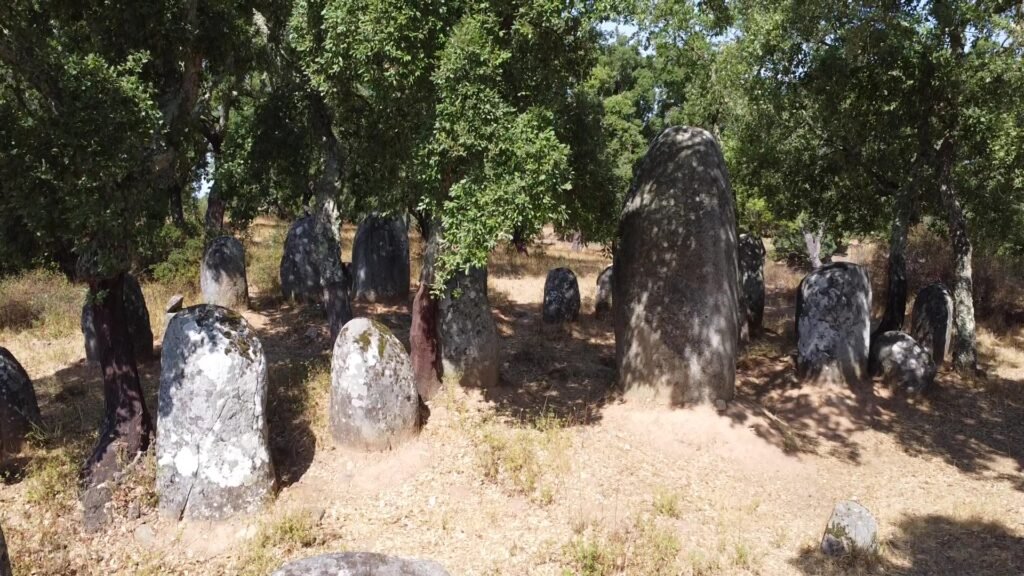
This is an oval cromeleque, made up of about 40 menires, carved from local stone. (“Grandodiorite” – a type of stone, like granite.) Many are shaped in an ovoid fashion, typical of the region’s menires. The oval is in an East/West orientation, with a major axis of about 15m and minor about 12m. 5 menires form a North/South interior axis, with the largest menir just North of centre.
Many of the stones (up to 11) have carvings, from cup marks (covinhas, in Portugal: “dimples”) to crosiers, incised lines, zigzags, circular shapes, and anthropomorphic representations. This is usually on a flattened face of the stone. They are similar in style to those found in other menires in the region, including Almendres. They are weathered and it is difficult to see the carvings when you are up close in bright sunlight. When I visited, I was able to just barely see the outline of the carvings on Menir 33.

These two, along with two similarly carved menires in the Almendres cromeleque were the first of this type found in Iberia, and they remain the only ones on the peninsula located in situ.
Note: I have included scans of images of the carvings from the book, Paisagens Arquológicas a Oeste de Évora1. The book is out of print, and I am including these images (giving credit) in the sense of "fair use."
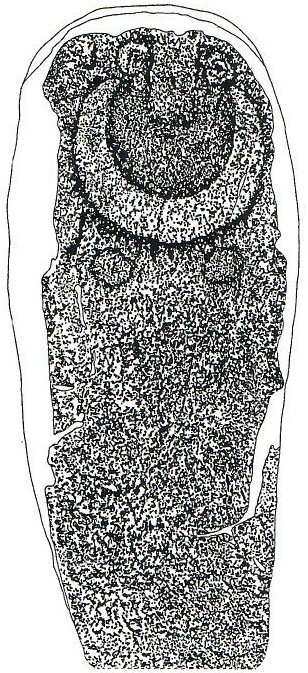
There is also an adjacent alignment of stones, in a line stretching to the East. There are six menires, forming a 30m alignment on the East side of the cromeleque.
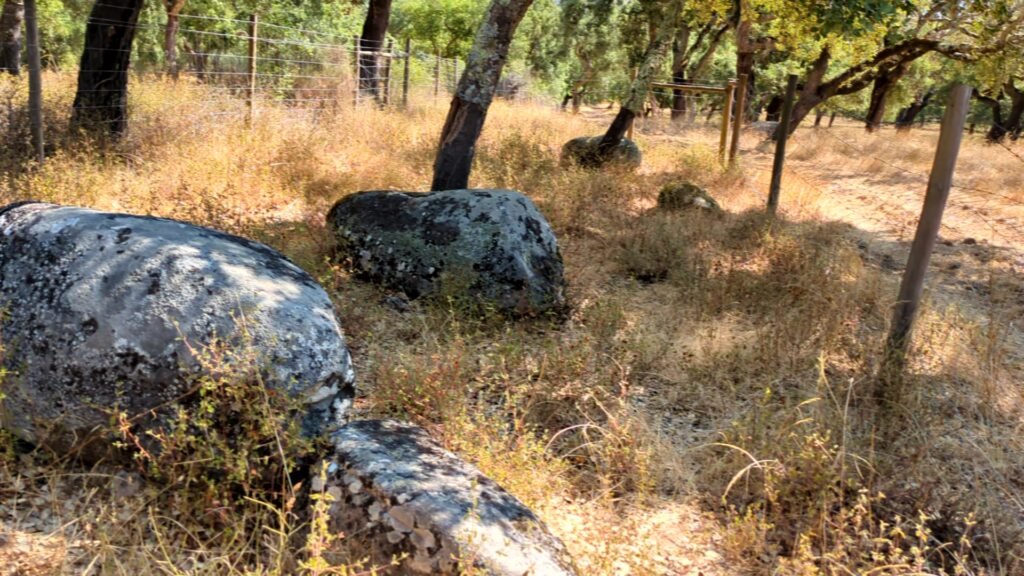
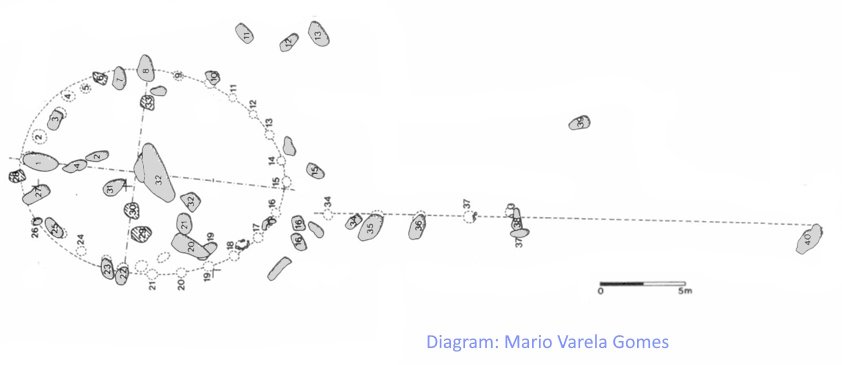
The site was first discovered in 1966 by Henrique Leonor Pina (who also identified the Cromeleque of Almendres). It was excavated in 1995 by Mario Varela Gomes, who also restored and rebuilt several menires. This archaeological work yielded a chronologically diverse collection, consisting of chipped stone artifacts and ceramic fragments.
The architectural configuration of the monument, along with many of the carvings and the artefacts found during excavation, place this site as being constructed in the Middle Neolithic (5th millennium BC), with reuse throughout the Chalcolithic and Bronze Age.
Location
The cromeleque is in the Alentejo, district and municipality of Évora, parish of Nossa Senhora da Tourega e Nossa Senhora de Guadalupe. It’s in a field just off the EN370 between the A6 motorway and the town of Nossa Senhora da Graça do Divor.
There is an unmarked gate along the EN370 road at these coordinates: 38.626543 -8.027737. Going through the gate, take the first path heading to the left and head up the hill. (It’s about 200m from the road.)
Access
The cromeleque is on a hill in a farm. It’s in private property, so be respectful. The gate is not locked, so you may enter but be sure to close the gate behind you. If possible, ask permission.
Personal note: When I visited, a couple on bicycles passed. “Are you going to visit the cromeleque?” they asked in Portuguese. “Absolutely,” I replied. “Please close the gate behind you,” they said. “Of course!” They smiled and nodded at me. Politeness and respect for others’ property will take you far in the Alentejo.
Signage
There are signs pointing out “Recintos Megalíticos” (“Megalithic Enclosures”) along the EN370: towards the north by Nossa Senhora da Graça do Divor, and at the southern end (near the A6 motorway), along the EN114 between Évora and Montomar-O-Novo.
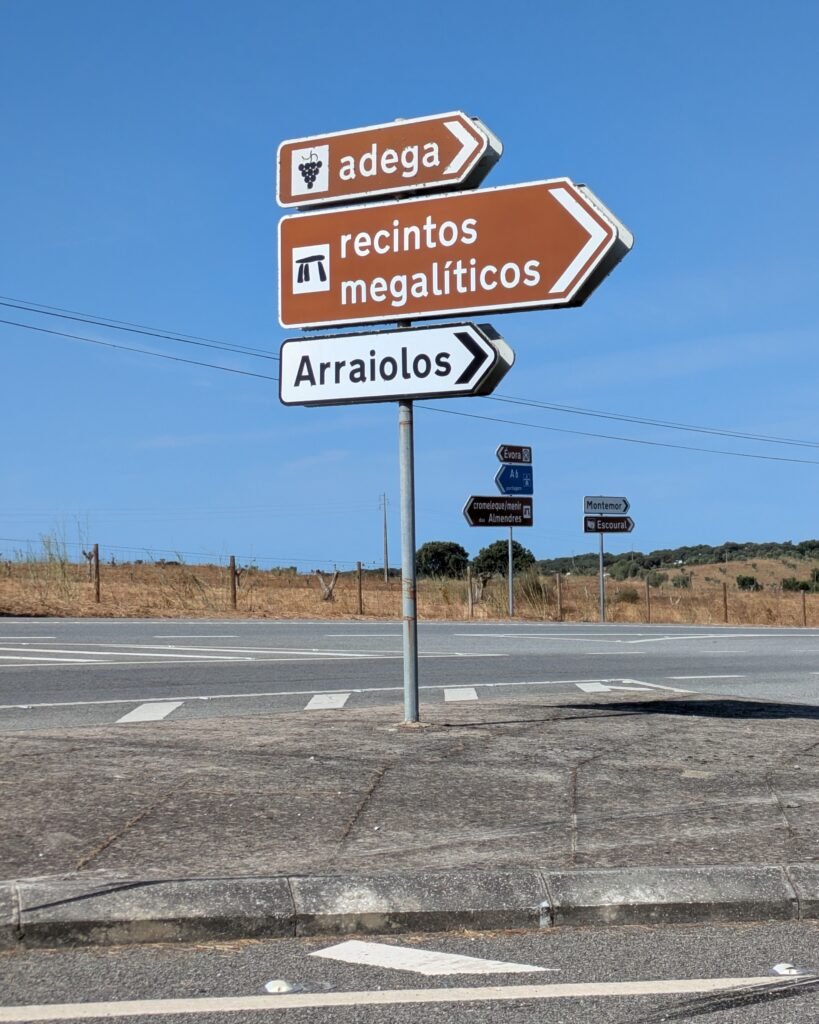
There are no signs directing you to the cromeleque.
Links
- Article (in Portuguese) from Wikipedia
- Entry (in English) in the Megalithic Portal
- 3D Model (description in English) from Global Digital Heritage
- Description (in Portuguese) from Archaeologist’s Portal of Directorate-General of Cultural Heritage
- Designation (in Portuguese) as a Property of Public Interest by the Directorate-General of Cultural Heritage
- Detailed information (in Portuguese) in the database of the Directorate-General of Cultural Heritage
Nearby
This cromeleque is very near to the Cromeleque de Vale Maria do Meio, which is about 1km to the northwest, towards Arraiolos.
Sources
- Gomes, Maria Varela. “Cromeleque Da Portela de Mogos: Um Monumento Sócio-Religioso Megalítico.” Paisagens Arquológicas a Oeste de Évora, by Câmara Municipal de Évora, Câmara Municipal de Évora, 1997, pp. 35–39. ISBN: 972-96965-4-3 ↩︎
- Cardoso, João Luís, et al. “Cromeleque de Portela de Mogos (Concelho de Évora) – Estudos Geoarqueológicos E Paleobotânicos.” A CIDADE de ÉVORA: Boletim de Cultura Da Câmara Municipal de Évora , vol. Série II, no 4, 2000, pp. 23–43, www.researchgate.net/publication/313771509_Cromeleque_de_Portela_de_Mogos_concelho_de_Evora_-_estudos_geoarqueologicos_e_paleobotanicos. Accessed 24 Apr. 2025. ↩︎
